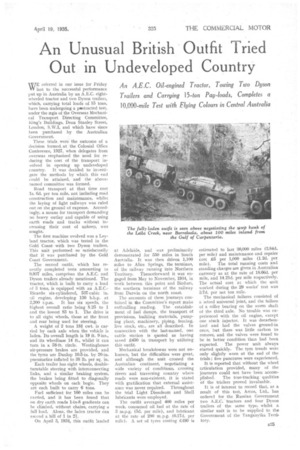An Unusual British Outfit Tried Out in Undeveloped Country
Page 35

If you've noticed an error in this article please click here to report it so we can fix it.
An A.E.C. Oil-engined Tractor, Towing Two Dyson Trailers and Carrying 15-ton Pay-loads, Completes a 10,000-mile Test with Flying Colours in Central Australia
WE referred in our issue for Friday IN last to the successful performance put up in Australia by an A.E.C. eightwheeled tractor and two Dyson trailers, which, carrying total loads of 15 tons, have been undergoing a pootracted test, under the wgis of the Overseas Mechanical Transport Directing Committee, King's Buildings, Dean Stanley Street, London, S.W.1, and which have since been purchased by the Australian Government.
These trials were the outcome of a decision formed. at the Colonial Office Conference, 1927, when delegates from overseas emphasized the need for reducing the cost of the transport involved in opening up undeveloped
country. It was decided to investigate the methods by which this end could be attained, and the abovenamed committee was formed.
Road transport at that time cost is. 6d. per ton mile, not including road construction and maintenance, whilst the laying of light railways was ruled out on the ground of expense. Accordingly, a means for transport demanding no heavy outlay and capable of using earth roads and tracks without increasing their cost of upkeep, was sought.
The first machine evolved was a Leyland .tractor, which was tested in the Gold Coastwith two Dyson trailers. This unit performed so satisfactorily that it was purchased by the Gold Coast Government.
The second outfit, which has recently completed tests amounting to 9,937 miles, comprises the A.E.C. and Dyson trailers already mentioned. The tractor, which is built to carry a load of 3 tons, is equipped with an A.E.C.Ricardo six-cylindered, 537-cubic in. oil engine, developing 130 b.h.p. at 2,200 r.p.m. It has six speeds, the highest overall ratio being 8.25 to 1 and the lowest 83 to 1. The drive is to all eight wheels, those at the front and rear being used for steering.
A weight of 2 tons 18f cwt. is carried by each axle when the vehicle is laden. Its overall length is 19 ft. 9 ins., and its wheelbase 14 ft., whilst it can turn in a 58-ft. circle. Westinghouse air-pressure brakes are provided, and the tyres are Dunlop 10.5-in. by 20-in. pneumatics inflated to :38 lb. per sq. in.
Each trailer has eight wheels, doubleturntable steering with interconnecting links, and a similar braking system, the brakes being fitted to diagonally opposite wheels on each bogie. They are each built to carry 6 tons.
Fuel sufficient for 160 miles can be carried, and it has been found that on dry Carth roads 1-in-8 gradients can he climbed, without chains, carrying a full load. Alone, the laden tractor can ascend a hill of 1 in 21.
On April 3, 1934, this outfit landed
at Adelaide, and was preliminarily demonstrated for 550 miles in South Australia. It was then driven 1,100 miles to Alice Springs, the terminus, of the railway running into Northern Territory. Thenceforward it was engaged from May to November, 1934, in work between this point and Birdum, the southern terminus of the railway from Darwin on the north coast.
The accounts of these journeys contained in Mae Committee's report make enthralling reading. The establishment of fuel dumps, the transport of provisions, building materials, pumping plant, machinery, piping, fencing, live stock, etc., are all described. In connection with the last-named, one cattle station is quoted as having saved 2450 in transport by utilizing this outfit.
Mechanical breakdowns were not unknown, but the difficulties were great, and although the unit •crossed the Australian continent negotiating a wide variety of conditions, crossing rivers and traversing country where roads were non-existent, it is stated with gratification that external assistance was never required. Throughout the trial Light Diesoleum arid Shell lubricants were employed.
The outfit averaged 400 miles per week, consumed oil fuel at the rate of 3 m.p.g. (5d. per mile), and lubricant at the rate of 280 m.p.g. (0.17d. per mile). A set of tyres costing £480 is estimated to last 80,000 miles (3.84d. per mile) and maintenance and repairs cost £5 per 1,000 miles (1.2d. per mile). The total running costs and standing charges are given in Australian currency as at the rate of 18.66d. per mile, and 14.21d. per mile respectively. The actual cost at which the unit worked during the 29 weeks' test was 3.7d. per net ton mile. The mechanical failures consisted of a seized universal joint, and the failure of a roller bearing on the worm shaft of the third axle. No trouble was experienced with the oil engine, except one stuck injector. It was decarbonized and had the valves ground-in once, but there was little carbon to remove, and the valves were found to be in better condition than had been expected. The power unit always started quickly. The tyre treads were only slightly worn at the end of the trials ; five punctures were experienced.
It is reported that without the wheel articulation provided, many of the journeys could not have been accom plished. The true-tracking qualities of the trailers proved invaluable.
It is of interest to record that, as a result of this test, Arcos, Ltd., has ordered for the Russian Government two A.E.C.• tractors and four Dyson trailers of the same type, whilst a similar unit is to be supplied to the Government of the Tanganyika Territory.




















































































